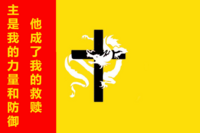Nanqing Clique
| Nanqing Clique | |
|---|---|
| 南青集团 | |
 One of the flags attributed to the Nanqing Clique, quoting Psalm 118:14 “The Lord is my strength and my defence; he has become my salvation.” | |
| Foundation | 1910s |
| Dissolved | 27 June 1934 |
| Active regions | Shangea |
| Ideology | Emperor Worship Ultranationalism Scientific racism Militarism |
The Nanqing Clique (Shangean: 南青集团, Nánqīng jítuán) was a political faction in imperial Shangea during the 1910s through to the 1930s, primarily active in the Heavenly Army and some bureaucratic circles. Based around the Church of Emperor Worship the Nanqing Clique agitated to overthrow the constitutional order in Shangea and create a "National-Military State" ((国立军事政府; guólì jūnshì zhèngfǔ) that would end political corruption, entrench the absolute rule of the emperor, expand Shangea's borders across Coius, promote a Sotirian moral order and uphold the racial supremacy of the Shangean race. It was named the Nanqing Clique as several of its founders - Ren Xilian and Yao Fuzhang - were born in Nanqing province.
The Nanqing clique formed out of radical sections of the army close to the Emperor Worship church which had been cultivated in the Heavenly Army by Qiu Hanjie. The movement was split between a military faction, nominally headed by Qiu but dominated by Ren Xilian and a civilian faction led by Cao Ghuozhang and Chen Ruoqing. The Nanqing Clique combined Sotirian millenarianism with Euclean-inspired functionalism and traditionalist royalism. The Nanqing Clique alongside the Emperor Worship Church grew in influence after the Great Collapse and resulting 1915-1916 famine alongside other far-right and ultranationalist groups such as the Shangea Expansion Group. The Nanqing Clique were supported by the cousin of the Qingzhuo Emperor the Prince Xun.
After the suppression of socialist groups during the Red Summer in 1920 the Nanqing Clique led the Jiayun Uprising that saw the Qingzhuo emperor placed under house arrest with power being divided between more traditionalist Zhao Hongjun, the Prince Xun and Nanqing Clique leaders Ren Xilian and Yao Fuzhang. In 1922 the Qingzhuo Emperor died under unclear circumstances leading to Prince Xun to be enthroned as the Shanrong Emperor. The Shanrong Emperor subsequently dismissed Zhao from office appointing a Nanqing Clique member Long Zhengxin as premier and Ren as head of the army.
The Nanqing Clique in government supported the "resettlement in the countryside" campaign deporting urban residents to rural areas, promoting assimilationist policies towards minorities and entering the Entente alliance with Gaullica. The Nanqing Clique had long promoted expansion into Senria but were unprepared for the Second Sakata Incident that triggered the Great War. During the war the Clique in government reached the zenith of its political influence with Ren being the mastermind behind the Shangean army and Cao Ghuozhang becoming premier, with the Nanqing Clique being the key instigator of the Senrian Genocide. The Nanqing Clique declined in influence as Shangea began to lose the war and after the invasion of Shangea by Senria Ren was removed from office. The Nanqing clique vanished from the political scene in 1934 when the Shanrong Emperor was killed and the First Shangean Republic declared with its senior members being mostly tried for warcrimes.
Although the Nanqing Clique functionally administrated Shangea for over a decade it never organised into a political party remaining a loose organisation based around personal guanxi networks and the Emperor Worship Church. Most of its members either were executed or imprisoned by the Grand Alliance or by Lu Keqians regime following the Shangean Civil War. The demise of the Nanqing Clique mirrored that of the Emperor Worship Church.